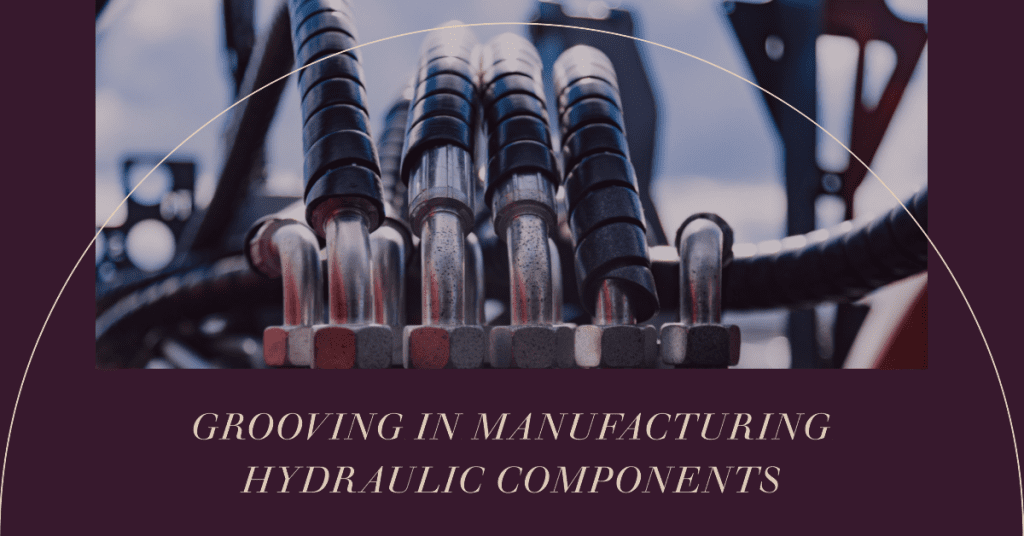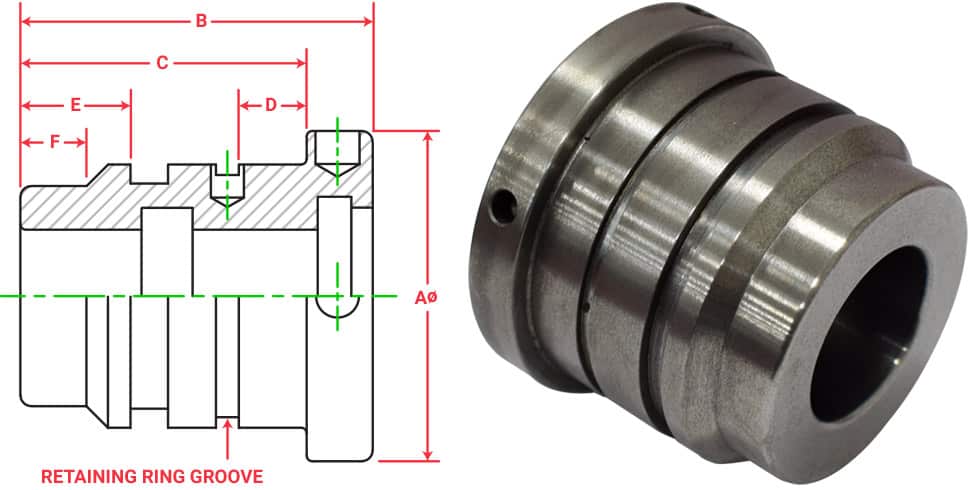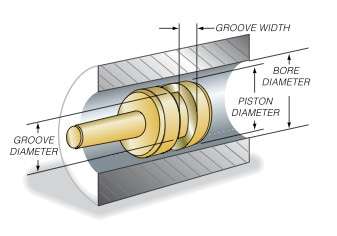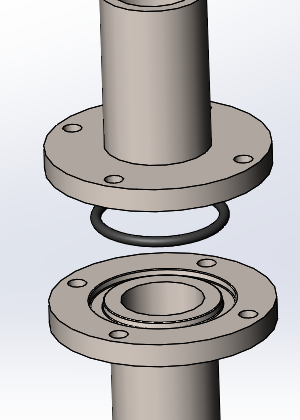Hydraulic systems play a pivotal role in various industries, including construction, automotive, and aerospace. One of the critical aspects of building reliable and efficient hydraulic systems is the manufacturing of its components. Grooving is a machining process that has proven to be an essential part of the hydraulic component manufacturing process.

This article explores the role of grooving in the manufacturing of hydraulic components, its benefits, and the various applications in which grooving is employed.
What is Grooving?

Hydraulic cylinder grooving
Grooving is a subtractive machining process used to create precise channels or recesses in a workpiece. Grooving tools, often CNC (Computer Numerical Control) machines, are employed to remove material from the workpiece, forming grooves with specific dimensions.
The process is versatile and applicable to various materials, such as metals, plastics, and composites. The precision and control provided by grooving make it an invaluable process in hydraulic component manufacturing.
Grooving in Hydraulic Component Manufacturing

Grooving for piston seal
1. Achieving Precise Dimensions
Precision is paramount in the manufacturing of hydraulic components. The reliability and performance of these systems hinge upon the tight tolerances and exact dimensions of each part. Grooving plays a vital role in achieving these precise dimensions by creating accurate channels, recesses, and sealing surfaces.
2. Tolerance and Dimensional Accuracy
Grooving allows for the creation of exact dimensions with impressive tolerance levels. This precision is necessary for the hydraulic components to function efficiently and cohesively. Misaligned or inaccurately machined parts can lead to system failure, making the precision offered by grooving essential.
3. Customization Capabilities
The grooving process can be customized to create a wide variety of shapes, depths, and widths, making it highly adaptable to the diverse requirements of hydraulic component manufacturing. The ability to tailor the grooving process ensures that each component can be accurately machined to the specific dimensions required.
Table: Tolerance Levels Achievable with Grooving
| Component | Tolerance Level |
|---|---|
| O-ring Grooves | +/- 0.001 inch |
| Spool Valve Channels | +/- 0.002 inch |
| Manifold Passageways | +/- 0.002 inch |
| Piston Channels | +/- 0.001 inch |
4. Ensuring Proper Sealing
Sealing is a critical aspect of hydraulic systems. Any leakage can lead to significant losses in system efficiency and potentially catastrophic failure. Grooving is crucial in ensuring the proper sealing of hydraulic components.
5. Creation of Sealing Surfaces
Grooving is used to create the sealing surfaces where O-rings, gaskets, and other sealing elements are placed. The precision of these grooves ensures that the seals fit snugly, preventing leaks and maintaining the integrity of the hydraulic system.
6. Grooves for Retaining Rings
In addition to sealing surfaces, grooving is also used to create grooves for retaining rings. These rings are used to secure components in place and prevent movement that could compromise the system’s integrity.
Table: Sealing Elements and Their Groove Requirements
| Sealing Element | Groove Requirement |
|---|---|
| O-ring | Precise circular groove |
| Gasket | Groove matching gasket shape |
| Retaining Ring | Accurate circular or semi-circular groove |
7. Enhancing Surface Finish
The surface finish of hydraulic components can significantly impact their performance. Grooving plays a vital role in ensuring optimal surface finish, contributing to the longevity and efficiency of the hydraulic system.
8. Reduction of Friction
A smoother surface finish reduces friction between moving parts, reducing wear and tear and extending the components’ lifespan. Grooving helps achieve this smooth surface finish, enhancing the overall performance of the hydraulic system.
9. Prevention of Leak Paths
Rough surfaces can provide potential leak paths in hydraulic systems. The smooth surface finish achieved through grooving helps seal these potential leak paths, improving system integrity and efficiency.
Table: Surface Finish Requirements and Grooving Role
| Component | Surface Finish Requirement | Grooving Role |
|---|---|---|
| O-ring Groove | Smooth to ensure the seal | Creates smooth groove surfaces |
| Spool Valve | Smooth for fluid flow | Creates smooth channels and recesses |
| Piston | Smooth for reduced friction | Provides smooth channels and recesses |
10. Reducing Manufacturing Time and Costs
Grooving, when performed using automated CNC machines, can significantly reduce manufacturing time and costs.
11. Efficiency and Speed
Automated CNC grooving processes can produce components faster than manual processes, increasing production rates and reducing the time it takes to manufacture each component. This increased efficiency translates to reduced manufacturing costs and quicker delivery times.
12. Reduction of Errors
CNC grooving also reduces the likelihood of errors that can occur with manual machining. By using computer programming to control the machining process, grooving can achieve higher precision and consistency, reducing the need for reworks or replacements due to faulty parts.
13. Scalability
Automated grooving allows for easy scalability. Once the CNC programming is set, multiple parts can be produced with the same precise specifications, making it ideal for large-scale manufacturing operations.
Table: Benefits of CNC Grooving in Manufacturing
| Benefit | Description |
|---|---|
| Increased Efficiency | CNC grooving processes can produce components faster than manual processes |
| Reduced Errors | CNC programming reduces the likelihood of machining errors |
| Scalability | Easy production of multiple parts with the same specifications |
| Cost Savings | Reduced labor costs and quicker production times lower overall manufacturing costs |
Applications
Grooving plays a vital role in hydraulic component manufacturing, serving various functions in different types of components. Here are a few applications where grooving is indispensable:
1. O-Ring Grooves

O-ring grooves are found in many hydraulic components, such as hydraulic cylinders, pumps, and valves. They are designed to house O-rings that provide sealing to prevent fluid leakage.
- Cylinders: In hydraulic cylinders, grooves are used to hold O-rings and other seals that prevent hydraulic fluid from escaping around the piston.
- Pumps and Motors: Grooves in hydraulic pumps and motors hold the seals necessary to maintain pressure within the system.
- Valves: Hydraulic valves use grooves to house sealing elements that prevent fluid leakage between the valve body and spool.
2. Channels and Passageways
Grooving is also used to create channels and passageways in hydraulic manifold blocks. These intricate grooves direct hydraulic fluid through the system, enabling the efficient operation of the hydraulic machinery.
3. Surface Grooves
Surface grooves are often incorporated into the design of hydraulic components to enhance their functionality. For example, they might be used to increase the surface area of a component for better heat dissipation or to create a textured surface that aids in grip or movement.
Table 2: Applications of Grooving in Hydraulic Component Manufacturing
| Component | Application of Grooving |
|---|---|
| Cylinders | Grooves hold O-rings and seals that prevent hydraulic fluid leakage |
| Pumps and Motors | Grooves maintain pressure within the system by holding necessary seals |
| Valves | Grooves house sealing elements to prevent fluid leakage |
| Manifold Blocks | Grooves create channels and passageways for directing hydraulic fluid |
| Various Components | Surface grooves enhance functionality, such as improving heat dissipation or providing texture |
Expert Tips
Achieving high-precision grooving for hydraulic component manufacturing can be a complex task. Here are some expert tips to guide you through the process:
- Understand Your Grooving Requirements: Before starting the grooving process, ensure you have a clear understanding of the required groove characteristics, including their dimensions, shape, and location. This information will guide the selection of the correct tool and parameters for the operation.
- Choose the Right Tool: The selection of the right grooving tool is critical. Consider the tool’s geometry, material, and compatibility with your CNC machine. Tools must be robust enough to withstand the demands of the operation and precise enough to achieve the required groove dimensions.
- Use Appropriate Cutting Parameters: Choosing the right cutting parameters is key to achieving high-quality grooves. Factors like cutting speed, feed rate, and depth of cut should be adjusted based on the tool material and the material being machined.
- Employ a Suitable Coolant: The use of a suitable coolant can help to extend tool life, improve surface finish, and enhance overall machining performance. Be sure to select a coolant that is compatible with your tool and workpiece materials.
- Regularly Check and Maintain Your Tools: Regular tool inspection and maintenance is essential to maintain the quality of your grooves. Ensure that tools are sharp and free from wear or damage before each operation.
- Ensure Accurate Positioning: Accurate positioning of the tool relative to the workpiece is critical for successful grooving. Use a precise setup and reliable work holding to maintain the correct tool position throughout the operation.
- Monitor the Machining Process: Constant monitoring of the machining process can help to identify and rectify any issues that may occur during the operation. This can prevent defects, tool damage, and unnecessary downtime.
Conclusion
The integral role of grooving in manufacturing hydraulic components cannot be overstated. As we’ve explored, grooving processes contribute significantly to the functionality and performance of various hydraulic components, enhancing system reliability. From pistons to valves and rotary actuators, grooving ensures optimum fit, aids in lubrication, and enhances sealing. However, executing successful grooving operations demands precision, the right tooling, and appropriate machining parameters.
Prolean’s grooving machining service offers high-precision grooving capabilities for rotary actuator manufacturing. With our advanced CNC machines and skilled machinists, we can achieve the exact specifications required for optimal actuator performance. Contact us today to learn more about our services and how we can support your manufacturing needs.
FAQ’s
Why is grooving important in hydraulic component manufacturing?
Grooving plays a crucial role in hydraulic component manufacturing as it helps create components with high precision and fit, aids in lubrication, and enhances sealing. This ultimately contributes to the efficiency and longevity of the hydraulic system.
How does grooving contribute to the manufacturing of hydraulic pistons?
In hydraulic pistons, grooves are used to house the seals that prevent fluid leakage. Therefore, precise grooving is vital for the effective operation of hydraulic pistons.
What is the role of grooving in hydraulic valve manufacturing?
Grooving in hydraulic valve manufacturing helps create the necessary pathways for fluid control, enabling the valve to regulate, direct, and control the flow of hydraulic fluids.
Why is grooving used in the manufacturing of rotary actuators?
Grooving in rotary actuators is used to facilitate the fit of sealing rings and O-rings. This ensures proper sealing, reducing the chance of fluid leakage and improving the actuator’s performance.
How can the efficiency of grooving operations be improved in hydraulic component manufacturing?
Efficiency can be improved by choosing the correct grooving tool based on the material and type of groove, using appropriate cutting parameters, ensuring proper cooling, and maintaining the tools regularly.




0 Comments